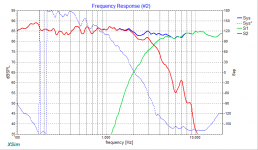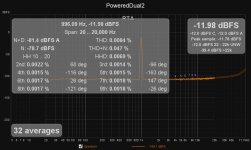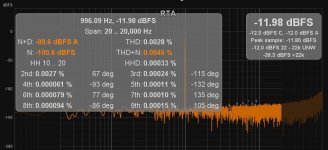These are the only planar headphones that I have so can only compare them with dynamic driver headphones and also hybrid dynamic driver with AMT tweeter. The HE-400i are very resolving without being fatiguing. The transient attack seems snappier than a dynamic driver. The bass is not as deep or powerful as my Status Audio OB-1 (55ohm) open back but it is better than Beyer DT-880 SE (250ohm). The HE-400i’s feel a little bulky so they can bump into things and not the best for listening if you are leaning back against a comfy high back chair. Whereas a lower profile headphone like the ESS 422H or OB-1’s are easier to wear. I would say the one thing I really like about these planars is the resolution and attack. They are a good reference to have as part of the lineup. Probably my favorite headphones are the OB-1’s, which unfortunately, are no longer made. They were also the least expensive of all the headphones. They sound the most natural, comfortable, great bass and balanced midrange and highs. I have a second set that I modified for balanced drive.
Thanks for the info. It sounds like a great planar to have and not as expensive as other planars.
Look at what I found. These diyaudio guys are crazy. Ah wait!.. 😀
Do you use EQ settings for your headphones?
Look at what I found. These diyaudio guys are crazy. Ah wait!.. 😀
Do you use EQ settings for your headphones?
No, I never use EQ on headphones or speakers. I don’t like to fuss because I switch between amps, speakers, DACs, preamps, headphones so often it would drive me crazy. For some people who have a set and fixed system they always use, it makes sense. Sigfried Linkwitz highly recommends use of a passive notch filter for IEMs to cancel the resonance caused by the closed tube waveguide your ear canal serves as. It’s at 7kHz I think.
Never though of that, but it makes sense. Was just reading on EQ curves for audio, and it turns out there can be a need to EQ for not only the Headphones themselves but for our own hearing on top of that.Sigfried Linkwitz highly recommends use of a passive notch filter for IEMs to cancel the resonance caused by the closed tube waveguide your ear canal serves as. It’s at 7kHz I think.
OTBT: The Behringer UMC202HD, and my second attempt at making this mod. First time was not successful as one solder joint wasn't done well, so one diode clamp not connected and pop went one op amp most probably. Left Channel is currently unusable.
Mustered some courage to plan modification of the Right Channel. Mods:

Before Mod (but DC Booster disabled), THD: 0.0026%, N: -99.1 dBFS at this level.

After Mod and less stringent FFT (so even this can be improved upon):
THD: 0.00071%, N: -100.7 dBFS at this new level.
Caveat: these two measurements aren't precisely comparable (FFT settings differ, levels differ) but provide a general idea nonetheless.

#Winning
Mustered some courage to plan modification of the Right Channel. Mods:
Before Mod (but DC Booster disabled), THD: 0.0026%, N: -99.1 dBFS at this level.
After Mod and less stringent FFT (so even this can be improved upon):
THD: 0.00071%, N: -100.7 dBFS at this new level.
Caveat: these two measurements aren't precisely comparable (FFT settings differ, levels differ) but provide a general idea nonetheless.
#Winning
Just find out the LSA Signature 80 speaker. It sound very dynamic, clean, clear and detail with a natural tone.The design of the LSA Signature 80 speakers is now completed and going to production. I really like how they sound.
LSA Signature 80 Design is Completed - YouTube
Are there any measurements such the polar map to see how wide the horizontal dispersion? What is the sensitivity on this? How dynamic when compare to the unity horn or the mainstream Klipsch horn (any of RP or R series like the RP-600m) speakers?
I'm looking to replace my KEF LS50 with the molded crossover because I'm converting the room for theater. The KEF can't keep the dynamic range and SPL peaks during movie. I'm looking for a more dynamic, higher sensitivity, a little better clarity with a big sweet spot like coaxial speaker. Thanks
The LSA Sig 80 is a great speaker. The little waveguide and 3.5kHz crossover frequency help to give this speaker a very uniform response over +/-30deg and down by 5dB at +/-45deg. These curves are at 0, 15, 30, 45deg. Sensitivity is nominally 84.5dB at 2.83v and 1m (4pi space). Typical sensitivity after baffle step losses for a HiFi 88dB woofer. The crossover is built using high quality components.
This is the crossover response:

Polar response:
 Crossover:
Crossover:

Impedance is no lower than 7ohms and no higher than 24ohms and smooth variations:

This is the crossover response:
Polar response:
Impedance is no lower than 7ohms and no higher than 24ohms and smooth variations:
Attachments
IMO, if you are looking for something that sounds better than the LS-50, the Signature 80 will surely do that and have better dynamics and clarity with a highly resolving top end that’s not fatiguing. It’s a bigger speaker (7in driver vs 5in) and naturally, the bass and ability to handle dynamic peaks will be better.
Here is what the LS50 crossover looks like:

compared to the Sig 80 XO PCB above.
Here is what the LS50 crossover looks like:
compared to the Sig 80 XO PCB above.
Last edited:
@xrk971 Thanks for the all information. The crossover looks top notch quality. Does the -5dB on 45 degree uniform response able to cover three seat sofa pretty well if sitting 8 ft from the front speakers? The KEF LS50 sweet spot cable to do it pretty.
Do you think the KEF center speaker might work well for LSA 80? I wanted to keep the KEF center speaker if possible due to better dispersion of the coaxial. If not, what would suggest to match the speed of planar driver?
Yeah, the stock KEF LS50 crossover looks very cheap to save money. That's why I copy the crossover mod, which makes a big difference and more balance too.
Do you think the KEF center speaker might work well for LSA 80? I wanted to keep the KEF center speaker if possible due to better dispersion of the coaxial. If not, what would suggest to match the speed of planar driver?
Yeah, the stock KEF LS50 crossover looks very cheap to save money. That's why I copy the crossover mod, which makes a big difference and more balance too.
If you draw a sketch with your speaker positions (8ft back) and spacing apart makes a difference. Assuming typical 5ft wide TV and speakers 7 ft apart the angle is arctan(3.5/8)=24deg to the middle of the sofa. If you toe-in the speakers a bit, I think a 5ft wide 3 person sofa should have pretty even coverage based on 60deg included angle.@xrk971 Thanks for the all information. The crossover looks top notch quality. Does the -5dB on 45 degree uniform response able to cover three seat sofa pretty well if sitting 8 ft from the front speakers? The KEF LS50 sweet spot cable to do it pretty.
Do you think the KEF center speaker might work well for LSA 80? I wanted to keep the KEF center speaker if possible due to better dispersion of the coaxial. If not, what would suggest to match the speed of planar driver?
Yeah, the stock KEF LS50 crossover looks very cheap to save money. That's why I copy the crossover mod, which makes a big difference and more balance too.
That’s looking really clean and nice SE Class A-like harmonic profile.
It looks quite good indeed. It's a bit too good to be useful for now as I only tested the internal REW generator through a unity-gain buffer with an old JFET-input op amp, powered by 9V batteries together with suitable PSU caps.That’s looking really clean and nice SE Class A-like harmonic profile.
I got these old op amps because one of my suppliers stealthily replaced the op amps I ordered, which were supposed to be TL082 and similar... They were originally planned for my DIY Analogue Modular synth so I am using them for various tests, including at one point, breaking the package to look at the die. The space occupied by the die area is really small compared to the package.
It will however be quite interesting to check how configurations with gain behave. This will be part of a subsequent battery of tests.
I will check with other old op amps and measure various setups. I will also be able to compare with newer, better op amps, some of which I obtained recently from Digikey. The package - op amps, JFETs and more - arrived quite fast as is usual with Digikey.
I don’t know enough about the KEF center channel. I do know that they are mostly for speech intelligibility. Probably a good full range there in a sealed box could work. Like like a ScanSpeak 10F (if you want to go all out) or Visaton B80 (mid tier) or even TC9FD (lower tier but still very good). Also very good for vocals is PA130-8. If higher sensitivity is what you need 3FE25 is also excellent.@xrk971 Thanks for the all information. The crossover looks top notch quality. Does the -5dB on 45 degree uniform response able to cover three seat sofa pretty well if sitting 8 ft from the front speakers? The KEF LS50 sweet spot cable to do it pretty.
Do you think the KEF center speaker might work well for LSA 80? I wanted to keep the KEF center speaker if possible due to better dispersion of the coaxial. If not, what would suggest to match the speed of planar driver?
Yeah, the stock KEF LS50 crossover looks very cheap to save money. That's why I copy the crossover mod, which makes a big difference and more balance too.
On the bench tonight is a Burson V6 dual opamp. Burson contacted me and offered to send me a sample and asked me to try it out and post what my listening impressions are. I received it about a month ago. I have been just too busy to try it until I had a little break today and gave it a try. All my projects use SOIC8 dual opamps. So John G. from Burson sent me some SMT to DIP8 adapters. I decided to use it on my HyperSET tube buffer which has an OPA1656 output opamp. I know the sound of this buffer very well. It can use either E88CC tubes or lately I am using NOS 6N1P tubes. First, I had to get out the hot air pencil to remove the existing OPA1656. Then hot air soldered the adapter.
Removing the old OPA1656:

Install the adapter:

Checking fit and continuity:

Install the Burson V6 onto the adapter:

Installed and powering up:

Source is Sanskrit Mk10 DAC and power amp is TDA7293 Xmas amp connected to my 10F/RS225 TL speakers. Initial listening with several tracks is very very good. I feel like the music is richer and bass is more articulate and strong. The sound is very enjoyable. I’ll give a more detailed listening impressions. After I have more time.
The adapter is very fragile as the opamp is so tall - the slightest bump will pop the solder pads off the board I fear. I need to provide DIP8 pads next time and use SOIC8 to DIP8 adapters.
Closeup:

Removing the old OPA1656:
Install the adapter:
Checking fit and continuity:
Install the Burson V6 onto the adapter:
Installed and powering up:
Source is Sanskrit Mk10 DAC and power amp is TDA7293 Xmas amp connected to my 10F/RS225 TL speakers. Initial listening with several tracks is very very good. I feel like the music is richer and bass is more articulate and strong. The sound is very enjoyable. I’ll give a more detailed listening impressions. After I have more time.
The adapter is very fragile as the opamp is so tall - the slightest bump will pop the solder pads off the board I fear. I need to provide DIP8 pads next time and use SOIC8 to DIP8 adapters.
Closeup:
Last edited:
It’s been on for 36 hrs straight and still sounding great. I think the burn in for the Burson’s and the 6N1P’s is complete. It looks really cool with the glow.

It's cool we have plenty of op amps devices to play with nowadays, and some are even designed for audio. Op amp package designs have come a long way, then there are thrid party discrete op amps like Burson and others and then we can also design our own discrete op amps with transistors.
The third party discretes are usually very expensive, making even the audio-specific op amps from large manufacturers look attractive regarding costs.
The third party discretes are usually very expensive, making even the audio-specific op amps from large manufacturers look attractive regarding costs.



